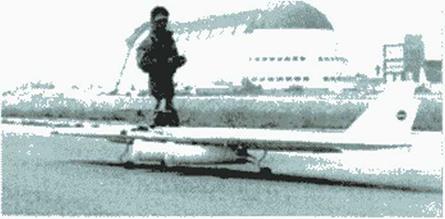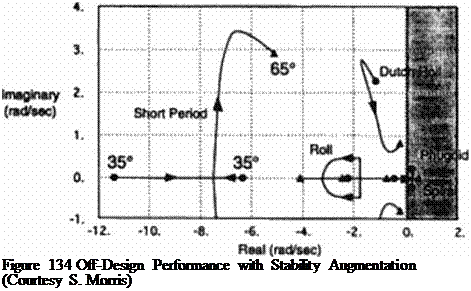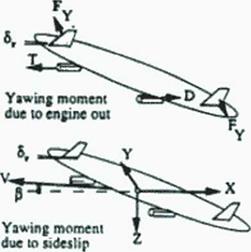Proof of Concept Demonstrators
In the summer of 1987. Steve Moms flew an unpowered model of an unswept flying wing with such an artificial stability augmentation system. The model was dynamically stabile with a center of gravity at 32*fr of the mean aerodynamic chord. In 1990 Dr. Moms built and flew a 10 ft span powered oblique flying wing that was naturally stable. This aircraft was flown at sweep angles up to 60 degrees.
|

After these initial successes. NASA Ames awarded a $ 250.000 two-year grant to build a 20 ft, two engined oblique wing demonstrator. Even though its w ingspan almost matches that of a Cessna 152. the model OFW is still relatively small compared to the 400 ft full scale aircraft. This model is shown in Figure 132; the layout of the model is shown in Figure 133. Its
![]()
![]()
![]() flight stability is determined by the quantities i =
flight stability is determined by the quantities i =
![]() pi/
pi/
 |
odynamic force and moment derivatives.
• Тею 5MP ducted fan angina*
• ![]()
 |
 |
Onboard computer and eeneore to
I.-„-. t, . M| ОДО———— г mi-^i – л —» _
іііірОїТівш »wCvfvl ПіуПі Oflll
Figure 133 Layout of the Twenty Foot Oblique Flying Wing Model (Courtesy S. Morris)
Both the full-size aircraft and the model have (lie same values of these parameters at takeoff. The aerodynamic derivatives are worse for the model because of Reynolds number effects. Figure 134 shows the calculated OFW off-design performance with stability augmentation in place.
 |
Swaap Vanes 35° to 55*
Closed-Loop w/Ttxad gains
The model, as designed, relied on simplified control laws that used only 6 fixed gains and made the assumption that pitch and yaw were decoupled. The current model aircraft is stable up to 50" at which point it becomes spirally unstable. The spiral instability could be controlled by a different control algorithm that adjusts the gain for different sweep angles.
Unfortunately, the designers of the model were hampered by lower than expected servo performance. Reliable servo performance could only be guaranteed at 3 Hz. The severely reduced servo bandwidth (10Н/ specification) allowed the model to be only flown 2 % unstable rather than the planned 7 %. Allowing for the performance deficit of the servos the model flew as predicted on May 10 1994 as shown in Figure 135. According to the report (400) : M The flight began w ith a 23 s take-off roll where the aircraft accelerated to 45 mph TAS and then lifted from the ground after the pilot rotated the airplane with a pitch-up command… The model then climbed to an altitude of 150 ft and proceeded to enter a left hand pattern During this pattern the model was flown at speeds as low as 25 mph and as high as 65 mph with wing sweep commanded to hold 35° . During the second left pattern the wing sweep was increased to 50° for a few seconds and then returned to 35° (as shown in Figure 136). At the end of the second pattern… the landing pattern was easily executed and the model landed safely on the runway centerline direcly in front of the the video cameras and the flight data was retrieved. The pilot commented that the airplane flew more easily than the 10 ft. model which had no on-board computer.
|
|
|
Sweep (<[11]9) |













